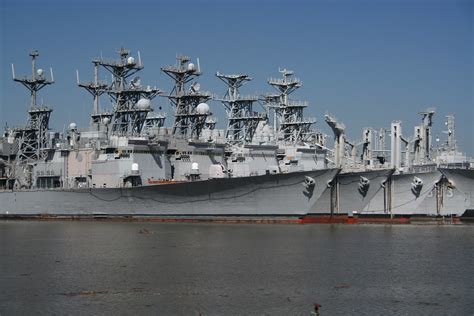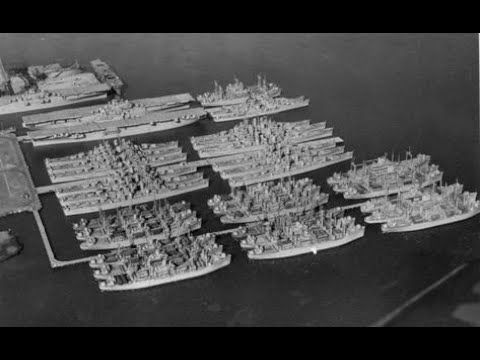U.s. Navy Mothball Fleet

The U.S. Navy's Mothball Fleet, officially known as the Reserve Fleet, is a collection of decommissioned military vessels that are preserved and maintained for potential future use. This fleet serves as a strategic reserve, ready to be reactivated and deployed in times of national emergency, conflict, or to meet specific operational requirements. The Mothball Fleet is a crucial component of the Navy's force structure, ensuring the availability of additional assets when needed. This comprehensive guide delves into the history, composition, maintenance, and potential future of the U.S. Navy's Mothball Fleet.
History and Evolution of the Mothball Fleet

The concept of a reserve fleet can be traced back to the early 20th century when the U.S. Navy recognized the need for a readily available pool of vessels to augment its active fleet during times of war or crisis. The term “mothball fleet” is believed to have originated from the practice of preserving vessels with a special chemical known as “mothballs” to prevent rust and corrosion during extended periods of inactivity.
The Reserve Fleet's history is closely tied to major conflicts and geopolitical events. During World War II, the fleet played a crucial role in providing additional warships and transport vessels to support the war effort. Post-war, many of these ships were mothballed, awaiting potential future conflicts or new missions. The fleet's composition and size have fluctuated over the years, with vessels being reactivated, decommissioned, and preserved based on the Navy's strategic needs and budget constraints.
In recent decades, the Mothball Fleet has seen significant changes in its composition and management. With advancements in naval technology and the retirement of older vessels, the fleet has transitioned from primarily consisting of World War II-era ships to a more modern collection of vessels. The Navy has also implemented new preservation and maintenance techniques to ensure the fleet's readiness and longevity.
Composition and Types of Vessels in the Mothball Fleet

The U.S. Navy’s Mothball Fleet is a diverse collection of naval vessels, each with its own unique history and potential for future reactivation. The fleet’s composition varies based on the Navy’s strategic requirements and the availability of specific ship types.
Aircraft Carriers
Aircraft carriers are among the most iconic and strategically important vessels in the Mothball Fleet. These massive warships, once fully operational, served as floating airbases, projecting air power and providing critical support during military operations. The Navy carefully selects and preserves aircraft carriers for potential reactivation, ensuring they remain in a state of readiness.
| Aircraft Carrier | Class | Status |
|---|---|---|
| USS Kitty Hawk (CV-63) | Kitty Hawk-class | Mothballed, awaiting disposal |
| USS John F. Kennedy (CV-67) | Modified Kitty Hawk-class | Mothballed, under consideration for reactivation |
| USS Constellation (CV-64) | Kitty Hawk-class | Scrapped in 2021 |

Cruisers and Destroyers
Cruisers and destroyers are versatile and highly capable warships, designed for a range of missions, including anti-aircraft defense, anti-submarine warfare, and surface combat. These vessels form a significant portion of the Mothball Fleet, providing a ready reserve of firepower and maneuverability.
| Cruiser/Destroyer | Class | Status |
|---|---|---|
| USS Lake Erie (CG-70) | Ticonderoga-class cruiser | Mothballed, under consideration for reactivation |
| USS Stout (DDG-55) | Spruance-class destroyer | Mothballed, awaiting disposal |
| USS Preble (DDG-88) | Arleigh Burke-class destroyer | Mothballed, under consideration for reactivation |
Amphibious Assault Ships
Amphibious assault ships are designed to support amphibious operations, transporting and deploying troops, vehicles, and equipment ashore. These versatile vessels can also serve as secondary aircraft carriers, providing a flexible platform for air support during operations.
| Amphibious Assault Ship | Class | Status |
|---|---|---|
| USS Peleliu (LHA-5) | Tarawa-class | Mothballed, awaiting disposal |
| USS Iwo Jima (LHD-7) | Wasp-class | Mothballed, under consideration for reactivation |
| USS Bonhomme Richard (LHD-6) | Wasp-class | Scrapped due to fire damage |
Other Support Vessels
In addition to the above-mentioned warships, the Mothball Fleet also includes a variety of support vessels, such as tankers, repair ships, and auxiliary vessels. These ships are crucial for maintaining the fleet’s operational readiness and providing essential services during deployments.
Maintenance and Preservation of the Mothball Fleet

Maintaining the Mothball Fleet is a complex and challenging task, requiring specialized techniques and dedicated resources. The Navy employs a range of preservation methods to ensure the vessels remain in a state of readiness, ready to be reactivated at a moment’s notice.
Preservation Techniques
One of the primary challenges in maintaining the Mothball Fleet is preventing corrosion and degradation of the vessels’ hulls and internal systems. The Navy uses a combination of techniques, including:
- Cathodic Protection: This method involves using sacrificial anodes to protect the vessel's hull from corrosion, ensuring its structural integrity.
- Desiccant Bags: These bags are placed in various compartments of the ship to absorb moisture, preventing rust and corrosion.
- Preservative Coatings: Special coatings are applied to the ship's exterior and interior surfaces to protect against corrosion and deterioration.
- Maintenance Crews: Dedicated maintenance crews regularly inspect and maintain the vessels, performing necessary repairs and upgrades to keep them in optimal condition.
Reactivation and Maintenance Facilities
The Navy has established specialized facilities to support the reactivation and maintenance of the Mothball Fleet. These facilities are equipped with the necessary infrastructure and personnel to efficiently bring the vessels back into service. The Navy’s Ship Repair and Maintenance Program ensures that the Mothball Fleet receives regular maintenance and upgrades to keep them ready for potential deployment.
Cost and Budgetary Considerations
Maintaining the Mothball Fleet is a costly endeavor, requiring significant budgetary allocations. The Navy carefully considers the cost-benefit analysis of preserving and reactivating vessels, balancing the need for a robust reserve fleet with budgetary constraints. The decision to reactivate a vessel is based on a comprehensive assessment of its strategic value, potential mission requirements, and the overall readiness of the active fleet.
Future of the Mothball Fleet

The future of the U.S. Navy’s Mothball Fleet is closely tied to the Navy’s strategic vision and the evolving geopolitical landscape. As the Navy continues to modernize its fleet and develop new technologies, the composition and role of the Mothball Fleet may undergo significant changes.
Potential Reactivations
With the ongoing global security challenges and the potential for unexpected conflicts, the Mothball Fleet provides a valuable strategic reserve. The Navy regularly evaluates the vessels in the fleet, considering their potential for reactivation based on changing mission requirements and the availability of newer assets. Some of the mothballed vessels, such as the USS John F. Kennedy and USS Lake Erie, are under consideration for reactivation, depending on the Navy’s future needs.
Disposal and Recycling
As the Navy’s active fleet continues to modernize and older vessels become less relevant, some mothballed ships are destined for disposal and recycling. The Navy follows a rigorous process for disposing of these vessels, ensuring environmental sustainability and responsible handling of hazardous materials. Ships that are no longer viable for reactivation, such as the USS Kitty Hawk and USS Constellation, are gradually being decommissioned and recycled.
Strategic Reserve and Force Structure
The Mothball Fleet remains a critical component of the Navy’s force structure, providing a strategic reserve of vessels that can be rapidly reactivated in times of need. As the Navy navigates an increasingly complex global security environment, the Mothball Fleet ensures the availability of additional assets to meet evolving mission requirements. The Navy’s ability to adapt and respond to emerging threats is closely tied to the readiness and composition of the Mothball Fleet.
What is the primary purpose of the Mothball Fleet?
+The primary purpose of the Mothball Fleet is to provide a strategic reserve of naval vessels that can be rapidly reactivated in times of national emergency, conflict, or to meet specific operational requirements. It ensures the availability of additional assets to support the active fleet and meet evolving mission needs.
How is the Mothball Fleet maintained and preserved?
+The Mothball Fleet is maintained through a combination of preservation techniques, including cathodic protection, desiccant bags, preservative coatings, and regular inspections by dedicated maintenance crews. These methods ensure the vessels remain in a state of readiness, ready for potential reactivation.
Can vessels in the Mothball Fleet be reactivated quickly?
+Yes, the Navy ensures that vessels in the Mothball Fleet are maintained in a state of readiness, allowing for rapid reactivation. The reactivation process involves a thorough inspection, upgrades, and necessary repairs to bring the vessel back to operational status. The time required for reactivation varies based on the vessel’s condition and the scope of work required.



